
Caryophyllaceae, commonly called the pink family or carnation family, is a family of flowering plants. It is included in the dicotyledon order Caryophyllales in the APG III system, alongside 33 other families, including Amaranthaceae, Cactaceae, and Polygonaceae. It is a large family, with 81 genera and about 2,625 known species.

Cytisus is a genus of flowering plants in the family Fabaceae, native to open sites in Europe, western Asia and North Africa. It belongs to the subfamily Faboideae, and is one of several genera in the tribe Genisteae which are commonly called brooms. They are shrubs producing masses of brightly coloured, pea-like flowers, often highly fragrant. Members of the segregate genera Calicotome, Chamaecytisus, and Lembotropis are sometimes included in Cytisus.

Specklinia is a genus of orchids native to South America, Central America, and the Caribbean. It contains approximately 100 species.

Orchis militaris, the military orchid, is a species of orchid native to Europe. It is the type species of the genus Orchis.

Anthyllis vulneraria, the common kidneyvetch, kidney vetch or woundwort is a medicinal plant native to Europe. The name vulneraria means "wound healer".
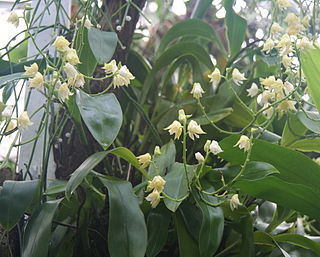
Polystachya, abbreviated Pol in horticultural trade, and commonly known as yellowspike orchid, is a flowering plant genus in the orchid family (Orchidaceae). This rather distinctive genus was described by William Jackson Hooker in 1824 and is the type genus of the subtribe Polystachyinae. It contains about 100 species widespread across many of the tropical areas of the world.
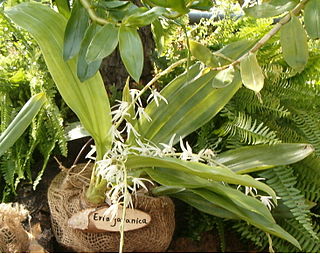
Eria is a genus of orchids with more than 50 species distributed in China, the Himalayas, the Indian Subcontinent, Southeast Asia, New Guinea, Polynesia, Melanesia and Micronesia.

Rhynchostylis is a genus in the orchid family (Orchidaceae), closely allied to the genus Vanda and comprising four currently accepted species native to the Indian Subcontinent, China, Indochina, Malaysia, Indonesia and the Philippines.

The genus Arachnis, abbreviated as Arach in horticultural trade, is a member of the orchid family (Orchidaceae), consisting of more than 20 species native to China, India, Southeast Asia, Indonesia, the Philippines, New Guinea, and the Solomon Islands.

Trichoglottis, commonly known as cherub orchids or 毛舌兰属 , is a genus of flowering plants in the family Orchidaceae. Orchids in this genus are epiphytic plants with thick roots, relatively thick, fibrous stems and many large, thick, leathery leaves arranged in two ranks. The flowers are usually small and yellowish with light brown or purple markings. The flowers have broad sepals, narrower petals and a labellum which has three lobes and is often hairy. There are about 85 species distributed from tropical and subtropical Asia to the north-western Pacific. Most species grow in rainforest.

Oncidium alexandrae, synonyms including Odontoglossum crispum, is an epiphytic orchid in the genus Oncidium. Known as the curled odontoglossum, it is considered by many to be the most beautiful orchid of all but is also one of the most difficult to grow.
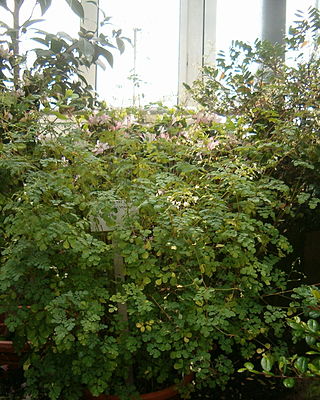
Boenninghausenia is a monotypic plant genus in the family Rutaceae. The sole species is Boenninghausenia albiflora, which occurs in Bhutan, Nepal, Pakistan, Kashmir, India, Indonesia, Philippines, Myanmar, Thailand, Laos, North Vietnam, China and Japan.

Tephroseris is a genus of Eurasian and North American plants in the groundsel tribe within the daisy family.

Brachycorythis is a genus of flowering plants from the orchid family, Orchidaceae. It contains approximately 40-50 species native mostly to Africa and Madagascar but also some from South and East Asia.
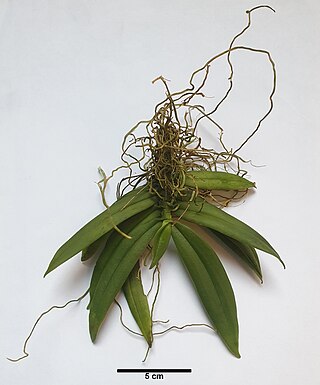
Grosourdya is a genus of flowering plants from the orchid family, Orchidaceae. As of May 2022, it contains 26 known species, native to Southeast Asia.
- Grosourdya appendiculata(Blume) Rchb.f. - widespread from Hainan to the Andaman Islands to the Philippines and Maluku
- Grosourdya bicornutaJ.J.Wood & A.L.Lamb - Sabah
- Grosourdya bigibba (Schltr.) Kocyan & Schuit.
- Grosourdya calliferaSeidenf. - Thailand
- Grosourdya ciliata (Ridl.) Kocyan & Schuit.
- Grosourdya decipiens (J.J.Sm.) Kocyan & Schuit.
- Grosourdya emarginata (Blume) Rchb.f.
- Grosourdya fasciculata (Carr) Kocyan & Schuit.
- Grosourdya incurvicalcar(J.J.Sm.) Garay - Java, Peninsular Malaysia, Sulawesi
- Grosourdya leytensis (Ames) Kocyan & Schuit.
- Grosourdya lobata Kocyan & Schuit.
- Grosourdya milneri P.O'Byrne, Gokusing & J.J.Wood
- Grosourdya mindanaensis (Ames) Kocyan & Schuit.
- Grosourdya minutiflora(Ridl.) Garay - Pahang
- Grosourdya minutissima P.T.Ong & P.O'Byrne
- Grosourdya multistrata P.O'Byrne, J.J.Verm. & S.M.L.Lee
- Grosourdya muscosa(Rolfe) Garay - Peninsular Malaysia, Thailand, Andaman Islands
- Grosourdya myosurus (Ridl.) Kocyan & Schuit.
- Grosourdya nitida (Seidenf.) Kocyan & Schuit.
- Grosourdya pulvinifera(Schltr.) Garay - Sabah, Sulawesi
- Grosourdya quinquelobata(Schltr.) Garay - Sulawesi
- Grosourdya reflexicalcarP.O'Byrne & J.J.Verm.
- Grosourdya tripercus(Ames) Garay - Leyte
- Grosourdya urunensisJ.J.Wood, C.L.Chan & A.L.Lamb - Sabah
- Grosourdya vietnamica (Aver.) Kumar & S.W.Gale
- Grosourdya zollingeri(Rchb.f.) Rchb.f. - Java, Maluku
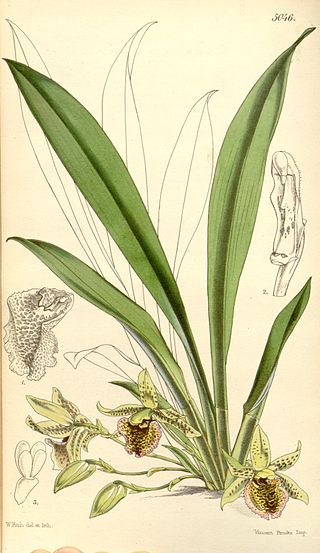
Kefersteinia is a genus of flowering plants from the orchid family, Orchidaceae. It has about 40-50 species, widespread across much of Latin America. The genus was named for Keferstein of Kröllwitz, an orchidologist.

Maxillariinae is an orchid subtribe in the tribe Cymbidieae. It was formerly treated as the tribe Maxillarieae, and divided into a number of subtribes.

Christian Stenhammar (1783-1866) was a Swedish naturalist interested in lichens and an entomologist who specialised in Diptera.His collection is held by Uppsala University. He was a clergyman.

Hladnikia is a monotypic genus of flowering plants belonging to the family Apiaceae. Its sole species, Hladnikia pastinacifolia, is a Slovenian paleoendemite, restricted to the area of only 4 km2, located in Trnovo Forest Plateau, karst plateau of Western Slovenia. German botanist Heinrich Gottlieb Ludwig Reichenbach named the genus after Carniolan botanist and founder of Ljubljana Botanical Garden Franz Hladnik.
Grafia is a monotypic genus of flowering plants belonging to the family Apiaceae. It only contains one species, Grafia golaka(Hacq.) Rchb.



















